Laughing kookaburra
| Laughing kookaburra | |
|---|---|
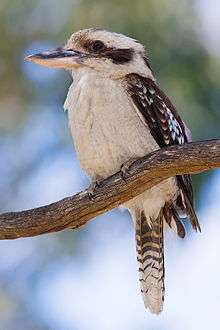 | |
| Bird recorded in southwestern Australia | |
| Scientific classification | |
| Kingdom: | Animalia |
| Phylum: | Chordata |
| Class: | Aves |
| Order: | Coraciiformes |
| Family: | Alcedinidae |
| Subfamily: | Halcyoninae |
| Genus: | Dacelo |
| Species: | D. novaeguineae |
| Binomial name | |
| Dacelo novaeguineae (Hermann, 1783) | |
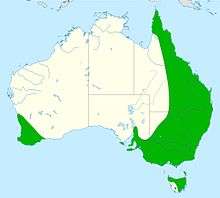 | |
| Distribution within Australia | |
| Synonyms | |
| |
The laughing kookaburra (Dacelo novaeguineae) is a carnivorous bird in the kingfisher subfamily Halcyoninae. Native to eastern mainland Australia, it has also been introduced to parts of New Zealand, Tasmania, and Western Australia. Male and female adults are similar in plumage, which is predominantly brown and white. A common and familiar bird, this species of kookaburra is well known for its laughing call.
Taxonomy
The first formal description of the laughing kookaburra was by the French naturalist Johann Hermann in 1783 under the scientific name Alcedo novæ Guineæ.[2][3] The current genus Dacelo was introduced in 1815,[4][5] and is an anagram of Alcedo, the Latin word for a kingfisher. The specific name novaeguineae combines the Latin novus for new with Guinea,[6] based on an erroneous belief that the specimen originated from New Guinea.[7] Hermann based his description on a coloured plate produced by the French naturalist Edme-Louis Daubenton which had the legend "Martin-pecheur, de la Nouvelle Guinée" (Kingfisher from New Guinea).[7][8] For many years it was believed that the earliest description was by the Dutch naturalist Pieter Boddaert and his scientific name Dacelo gigas was used in the scientific literature[9] but in 1926 the Australian ornithologist Gregory Mathews showed that a description by Hermann had been published earlier in the same year, 1783, and thus had precedence.[7][10]
In the 19th century this species was commonly called the "laughing jackass", a name first recorded (as Laughing Jack-Ass) in An Account of the English Colony in New South Wales by David Collins which was published in 1798.[11][12] In 1865 the ornithologist John Gould used "great brown kingfisher", a name that had been coined by John Latham in 1782.[13][14] Another popular name was "laughing kingfisher".[12]
European authors listed forms from Australian indigenous languages including Go-gan-ne-gine by Collins in 1878,[11] Cuck'anda by René Lesson in 1828[15] and Gogera or Gogobera by George Bennett in 1834.[16] In the early years of the 20th century "kookaburra" was included as an alternative name in ornithological publications[17][18] but it was not until 1926 in the second edition of the Official Checklist of Birds of Australia that the Royal Australasian Ornithologists Union officially adopted the name "laughing kookaburra".[12] The name comes from Wiradhuri, an Aboriginal language now effectively extinct.[12]
Two subspecies are recognised:[19]
- D. n. novaeguineae (Hermann, 1783) – the nominate subspecies, east Australia, Tasmania and southwest Australia
- D. n. minor Robinson, 1900 – northeast Australia[20]
Description
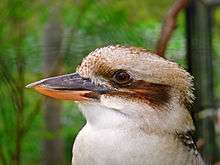
The laughing kookaburra is the largest kingfisher.[21] It is a stout, stocky bird 39–42 cm (15–17 in) in length, with a large head, prominent brown eyes, and a very large bill. The sexes are very similar, although the female is usually larger and has less blue to the rump than the male. The male weighs 310–345 g (10.9–12.2 oz) and the female 355–480 g (12.5–16.9 oz). They have a white or cream-coloured body and head with a dark brown stripe across each eye and more faintly over the top of the head. The wings and back are brown with sky blue spots on the shoulders. The tail is rusty reddish-orange with dark brown bars and white tips on the feathers. The heavy bill is black on top and bone-coloured on the bottom. The subspecies D. n. minor has a similar plumage to the nominate but is smaller in size.[21]
Call

The name "laughing kookaburra" refers to the bird's "laugh", which it uses to establish territory amongst family groups. It can be heard at any time of day, but most frequently shortly after dawn and after sunset to dusk.
One bird starts with a low, hiccuping chuckle, then throws its head back in raucous laughter: often several others join in. If a rival tribe is within earshot and replies, the whole family soon gathers to fill the bush with ringing laughter. Hearing kookaburras in full voice is one of the more extraordinary experiences of the Australian bush, something even locals cannot ignore; some visitors, unless forewarned, may find their calls startling.[22]
Distribution and habitat
The laughing kookaburra is native to eastern Australia, and has also been introduced to Tasmania, Flinders Island, and Kangaroo Island.[23]
Some were also introduced to New Zealand between 1866 and 1880, but only those released on Kawau Island by Sir George Grey survived. Descendants of these individuals are found there today. Remnants of this population have been seen on the New Zealand mainland near Matakana.
Individuals were released at Perth, Western Australia, in 1898 and can now be found throughout southwest Australia.
Behaviour
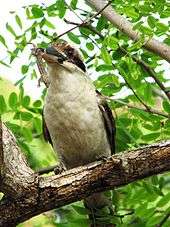
Kookaburras occupy woodland territories (including forests) in loose family groups, and their laughter serves the same purpose as a great many other bird calls—to mark territorial borders. Most species of kookaburras tend to live in family units, with offspring helping the parents hunt and care for the next generation of offspring.
Breeding
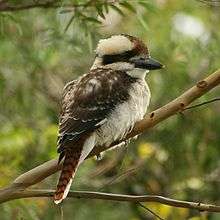
During mating season, the laughing kookaburra reputedly indulges in behaviour similar to that of a wattlebird. The female adopts a begging posture and vocalises like a young bird. The male then offers her his current catch accompanied with an "oo oo oo" sound. However, some observers maintain that the opposite happens - the female approaches the male with her current catch and offers it to him. Either way, they start breeding around October/November. If the first clutch fails, they will continue breeding into the summer months.
They generally lay three eggs at about two-day intervals. If the food supply is not adequate, the third egg will be smaller and the third chick will also be smaller and at a disadvantage relative to its larger siblings. Chicks have a hook on the upper mandible, which disappears by the time of fledging. If the food supply to the chicks is not adequate, the chicks will quarrel, with the hook being used as a weapon. The smallest chick may even be killed by its larger siblings. If food is plentiful, the parent birds spend more time brooding the chicks, so the chicks are not able to fight.
Feeding
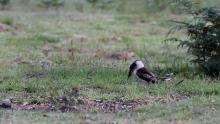
Kookaburras hunt much as other kingfishers (or indeed Australasian robins) do, by perching on a convenient branch or wire and waiting patiently for prey to pass by. Common prey include mice and similar-sized small mammals, large insects, lizards, small birds and nestlings, and most famously, snakes. Small prey are preferred, but kookaburras sometimes take large creatures, including venomous snakes, much longer than their bodies.
Status
The population density of the laughing kookaburra in Australia varies between 0·04 and 0·8 birds/ha depending on the habitat. Assuming an average of 0.3 birds/ha the total population may be as large as 65 million individuals.[21] The population in New Zealand is relatively small and is probably less than 500 individuals.[24] Given the extended range and the large stable population, the species is evaluated as of "least concern" by the International Union for Conservation of Nature.[1]
Interaction with humans
Laughing kookaburras are a common sight in suburban gardens and urban settings, even in built-up areas, and are so accustomed to humans that they will often eat out of their hands. It is not uncommon for kookaburras to snatch food out of people's hands without warning, by swooping in from a distance. People often feed them pieces of raw meat.
The kookaburra is also the subject of a popular Australian children's song, the "Kookaburra" which was written by Marion Sinclair in 1934.[25]
References
- 1 2 BirdLife International (2012). "Dacelo novaeguineae". IUCN Red List of Threatened Species. Version 2013.2. International Union for Conservation of Nature. Retrieved 26 November 2013.
- ↑ Peters, James Lee, ed. (1945). Check-list of Birds of the World. Volume 5. Cambridge, Massachusetts: Harvard University Press. p. 190.
- ↑ Hermann, Johann (1783). Tabula affinitatum animalium olim academico specimine edita : nunc uberiore commentario illustrata cum annotationibus ad historiam naturalem animalium augendam facientibus (in Latin). Argentorati: Impensis Joh. Georgii Treuttel. p. 192 Note.
- ↑ Peters, James Lee, ed. (1945). Check-list of Birds of the World. Volume 5. Cambridge, Massachusetts: Harvard University Press. p. 189.
- ↑ Leach, William Elford (1815). The Zoological Miscellany; being descriptions of new, or interesting Animals. Volume 2. London: B. McMillan for E. Nodder & Son. p. 125.
- ↑ Jobling, James A. (2010). The Helm Dictionary of Scientific Bird Names. London: Christopher Helm. pp. 130, 275. ISBN 978-1-4081-2501-4.
- 1 2 3 Mees, G.F. (1977). "The scientific name of the Laughing Kookaburra: Dacelo gigas (Boddaert) v. Dacelo novaeguineae (Hermann)". Emu. 77 (1): 35–36.
- ↑ Daubenton, Edme-Louis (1765–1783). Planches enluminées d'histoire naturelle. Volume 7. Paris. Plate 663.
- ↑ Boddaert, Pieter (1783). Table des planches enluminéez d'histoire naturelle de M. D'Aubenton (in French). Utrecht. p. 40.
- ↑ Mathews, Gregory M. (1926). "An important date". Emu. 26: 148.
- 1 2 Collins, David (1798). An Account of the English Colony in New South Wales. London: T. Cadell Jr and W. Davies. Appendix 12 Language.
- 1 2 3 4 Gray, Jeannie; Fraser, Ian (2013). Australian Bird Names: A Complete Guide. Collingwood VIC, Australia: CSIRO. pp. 156–158. ISBN 978-0-64310469-3.
- ↑ Gould, John (1865). Handbook to The birds of Australia. Volume 1. London: Self-published. p. 122.
- ↑ Latham, John (1782). A General Synopsis of Birds. Volume 1. London: Printed for Benj. White. p. 609.
- ↑ Lesson, René Primeverre (1828). Manuel d'ornithologie, ou description des genres et des principales espèces d'oiseaux (in French). Paris: Roret. p. 93.
- ↑ Bennett, George (1834). Wandering in New South Wales, Batavia, Pedir Coast, Singapore, and China: being the journal of a naturalist in those countries during 1832, 1833, and 1834. Volume 1. London: Richard Bentley. p. 222.
- ↑ Lucas, A.H.S.; Le Souef, W.H. Dunley (1911). The Birds of Australia. London: Whitcombe and Tombs. pp. 236–237.
- ↑ Leach, John Albert (1912). An Australian bird book: a pocket book for field use (2nd ed.). Melbourne: Whitcombe & Tombs. p. 105.
- ↑ Gill, Frank; Donsker, David, eds. (2016). "Rollers, ground rollers & kingfishers". World Bird List Version 6.3. International Ornithologists' Union. Retrieved 10 October 2016.
- ↑ Robinson, Herbert Christopher (1900). "Contributions to the zoology of north Queensland". Bulletin of the Liverpool Museums. 2 (3&4): 116.
- 1 2 3 Fry, C. H.; Fry, Kathie; Harris, Alan (1999). Kingfishers, Bee-eaters and Rollers. London: Christopher Helm. pp. 133–136. ISBN 978-0-7136-5206-2.
- ↑ http://ausinternet.com/ettamogah/kookaburrasong.htm
- ↑ Higgins 1999, p. 1125.
- ↑ Michaux, B. (2013). Miskelly, C.M., ed. "Laughing kookaburra". New Zealand Birds Online. Retrieved 4 October 2016.
- ↑ Howell, P. A. (2012). "Sinclair, Marion (1896–1988)". Australian Dictionary of Biography. Canberra: Australian National University. Retrieved 8 October 2016.
Sources
- Higgins, Peter J., ed. (1999). "Dacelo novaeguineae Laughing Kookaburra" (PDF). Handbook of Australian, New Zealand and Antarctic Birds. Volume 4: Parrots to dollarbird. Melbourne: Oxford University Press. pp. 1121–1138. ISBN 978-0-19-553071-1.
External links
| Wikimedia Commons has media related to Dacelo novaeguineae. |
| Wikispecies has information related to: Dacelo novaeguineae |
